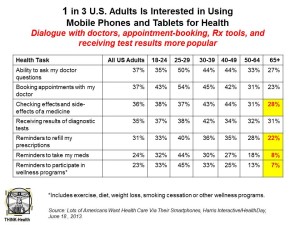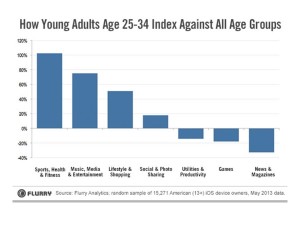 The headline for the HarrisInteractive/HealthDay mobile health (mHealth) survey reads, “Lots of Americans Want Health Care Via Their Smartphones.” But underneath that bullish forecast are statistics illustrating that the heaviest users of health care services in America — people 65 and over — have the least interest in mHealth tools.
The headline for the HarrisInteractive/HealthDay mobile health (mHealth) survey reads, “Lots of Americans Want Health Care Via Their Smartphones.” But underneath that bullish forecast are statistics illustrating that the heaviest users of health care services in America — people 65 and over — have the least interest in mHealth tools.
Overall, 37% of U.S. adults are interested in managing health via smartphones or tablets: about 1 in 3 people. As the chart shows, the greatest interest in communicating with doctors via mobile phones and tablets is among people 25-49. Reminders to fill prescription and participate in wellness programs is also higher among younger adults.
When it comes to the health activities most common among people 65 and over — such as checking side effects of medications, reminders to refill and take medicines — interest in mobile tool support for these tasks is lowest among the oldest health consumers, at 28% (vs. 36% overall), 22% (vs. 31% overall), and 8% (vs. 24% overall), respectively.
The Harris/HealthDay findings are confirmed in another study by Flurry, a data analytics company, that found among iOS smartphone users (Apple phones), younger adults are the most keen on sports, health and fitness apps.
Health care tracking functions people are most keen about are:
- Checking blood pressure, with 38% interested
- Checking heart irregularities, 36%
- Using an application to track health (e.g., diet, exercise), 34%
- Photographing eye, cornea or retina to diagnose an eye problem, 32%
- Checking blood sugar or glucose level, 32%
- Measuring lung function, 29%.
 Intriguingly, people who are currently taking a prescription medication for a chronic condition do not have a significantly higher level of interest in performing any of these functions compared to the general online population.
Intriguingly, people who are currently taking a prescription medication for a chronic condition do not have a significantly higher level of interest in performing any of these functions compared to the general online population.
The online survey was conducted in May 2013 among 2,050 adults 18 and over.
Health Populi’s Hot Points: With “patient engagement” the buzzword for 2013, the important finding here is that older people and those managing chronic conditions don’t have a greater interest in using mobile tools for self-care. Is this a chicken-and-egg problem? If interest in using mobile tools for health is a proxy for health engagement, then perhaps this is indeed a phenomenon of people less inclined to do self-care perpetuating ill health and “un-wellness.”
Looking at the second-oldest cohort of 50-64 — Boomers and middle-age adults — interest in health-engagement for self-tracking indexes much higher than among the 65+:
- Checking blood pressure, 38% for 50-64 vs. 24% for 65+
- Checking heart, 34% vs. 26%
- Using an app to track health, 28% vs. 13%
- Checking blood glucose, 30% vs. 21%
- Measuring lung function, 29% vs. 19%.
Except for using apps to track health, the 50-64 year old cohort matches or comes within 1 percentage point of the overall population for these metrics.
Thus, online Boomers should be expected to take on self-tracking as they age as a natural progression of using mobile phones and tablets in everyday life.
Today, the big missing link here is bolstering older peoples’ adherence to prescription medications. Can mobile tools help older people stick to therapeutic prescription regimens? This is the challenge and opportunity for pharma and life science companies, community pharmacies, and innovative designers to address.




 Interviewed live on BNN Bloomberg (Canada) on the market for GLP-1 drugs for weight loss and their impact on both the health care system and consumer goods and services -- notably, food, nutrition, retail health, gyms, and other sectors.
Interviewed live on BNN Bloomberg (Canada) on the market for GLP-1 drugs for weight loss and their impact on both the health care system and consumer goods and services -- notably, food, nutrition, retail health, gyms, and other sectors. Thank you, Feedspot, for
Thank you, Feedspot, for  As you may know, I have been splitting work- and living-time between the U.S. and the E.U., most recently living in and working from Brussels. In the month of September 2024, I'll be splitting time between London and other parts of the U.K., and Italy where I'll be working with clients on consumer health, self-care and home care focused on food-as-medicine, digital health, business and scenario planning for the future...
As you may know, I have been splitting work- and living-time between the U.S. and the E.U., most recently living in and working from Brussels. In the month of September 2024, I'll be splitting time between London and other parts of the U.K., and Italy where I'll be working with clients on consumer health, self-care and home care focused on food-as-medicine, digital health, business and scenario planning for the future...